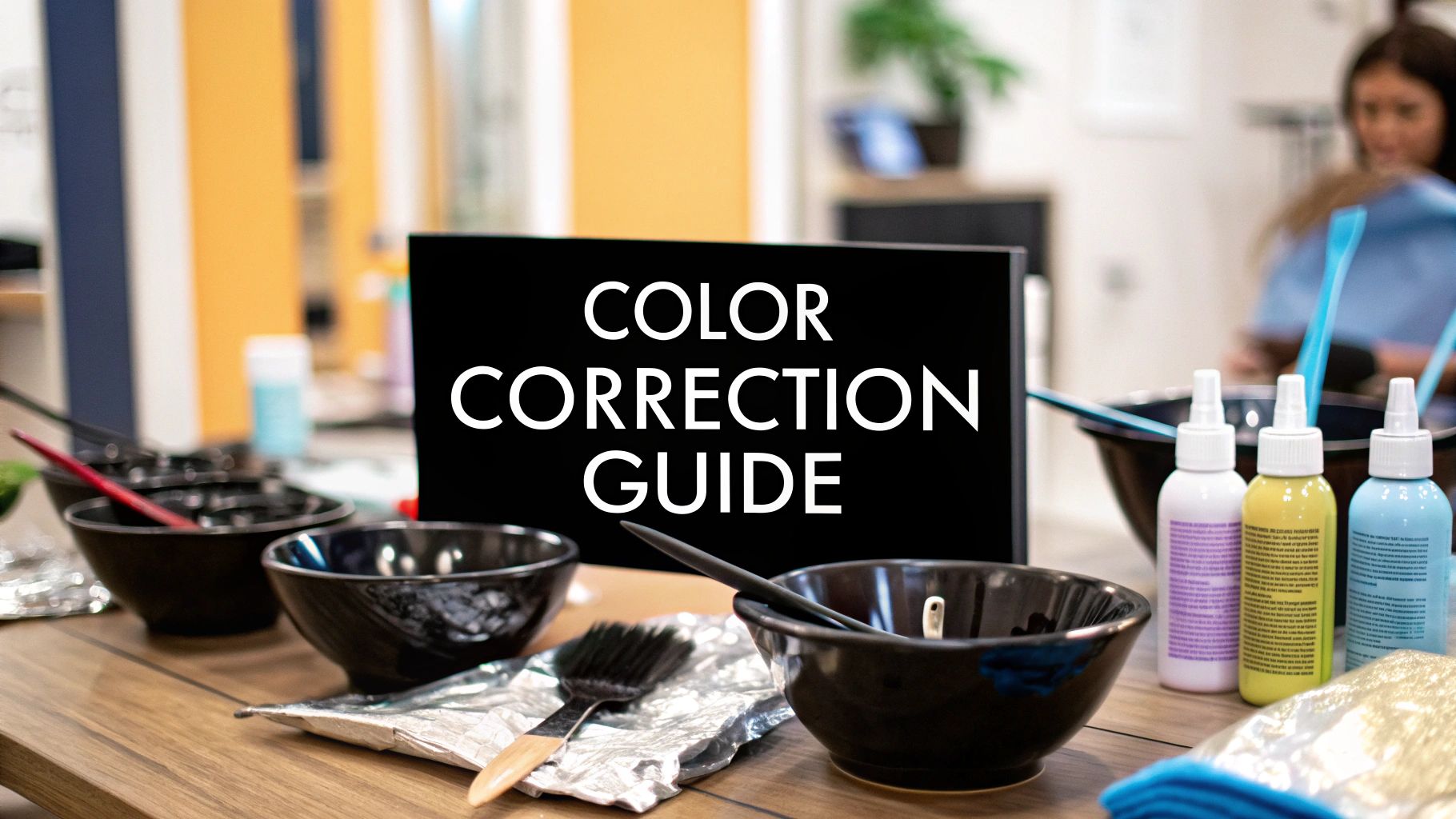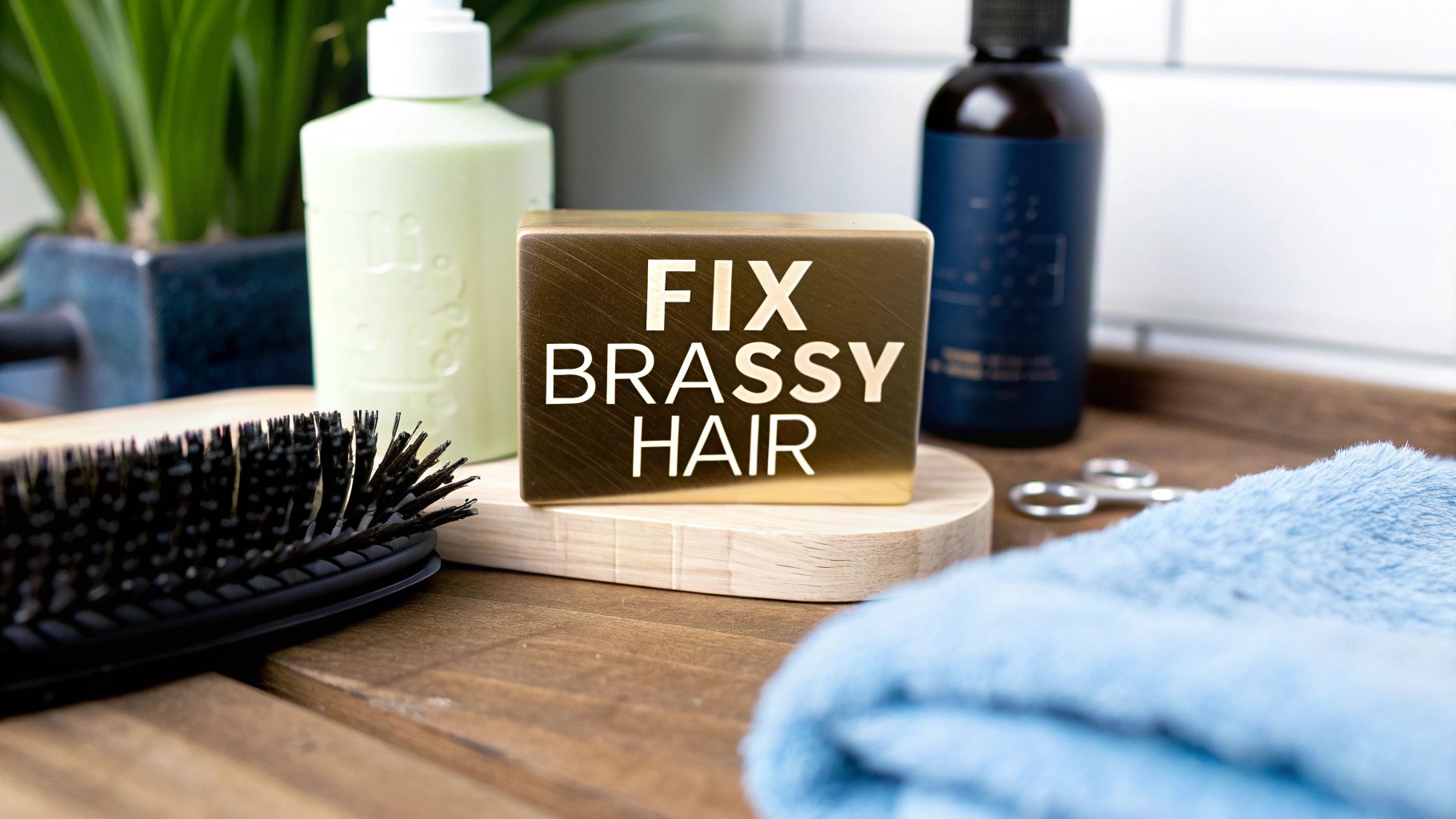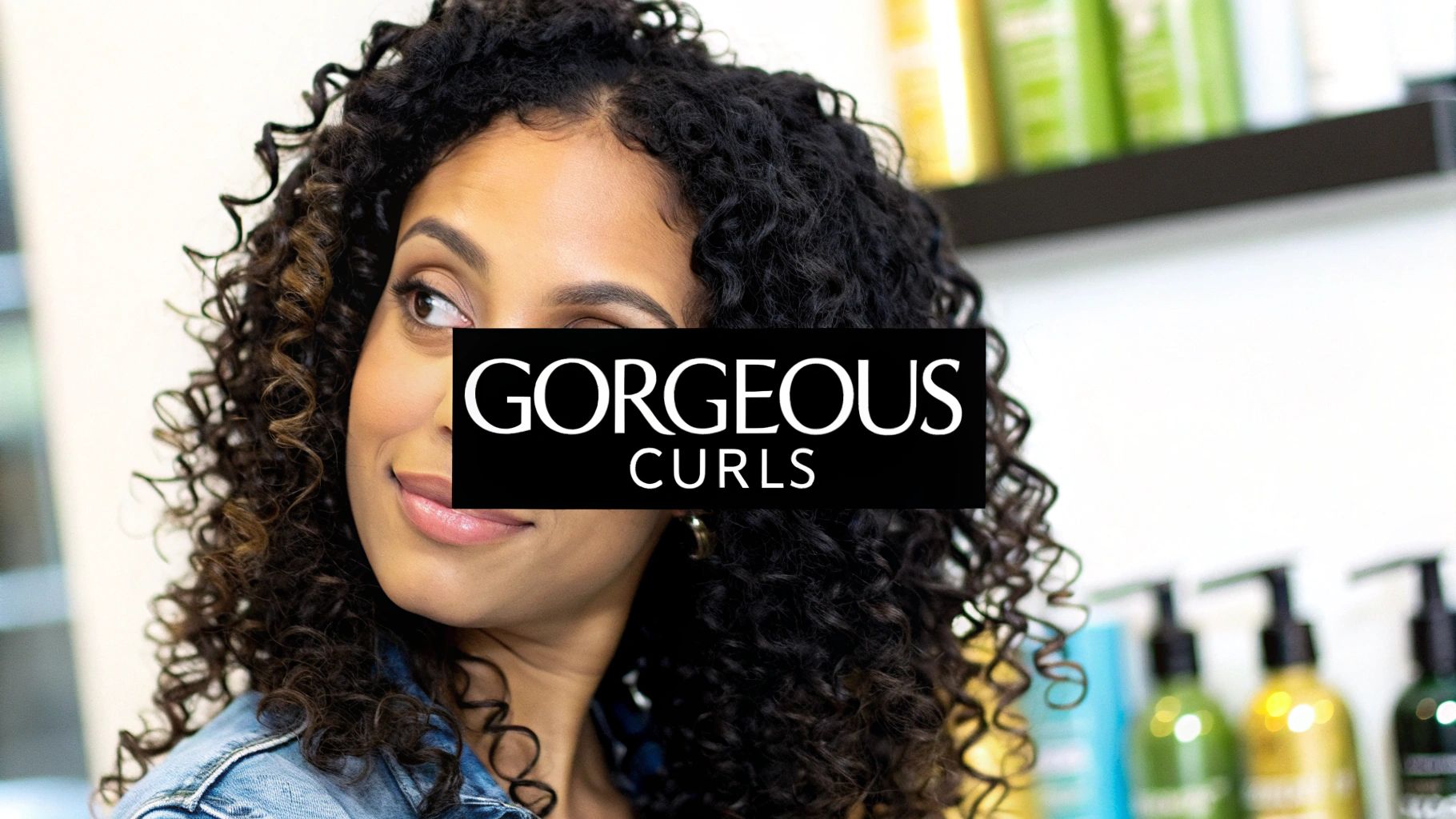So, what exactly is hair color correction? Think of it as the emergency room for your hair. It’s a specialized salon service that swoops in to fix a hair color that's gone wrong. This isn't just slapping a new color on top of an old one; it's a careful process of fixing unwanted tones, blending out patchy spots, or making a major color change, all while keeping your hair's health the top priority.
Thank you for reading this post, don't forget to subscribe!Why Would You Need a Hair Color Correction?
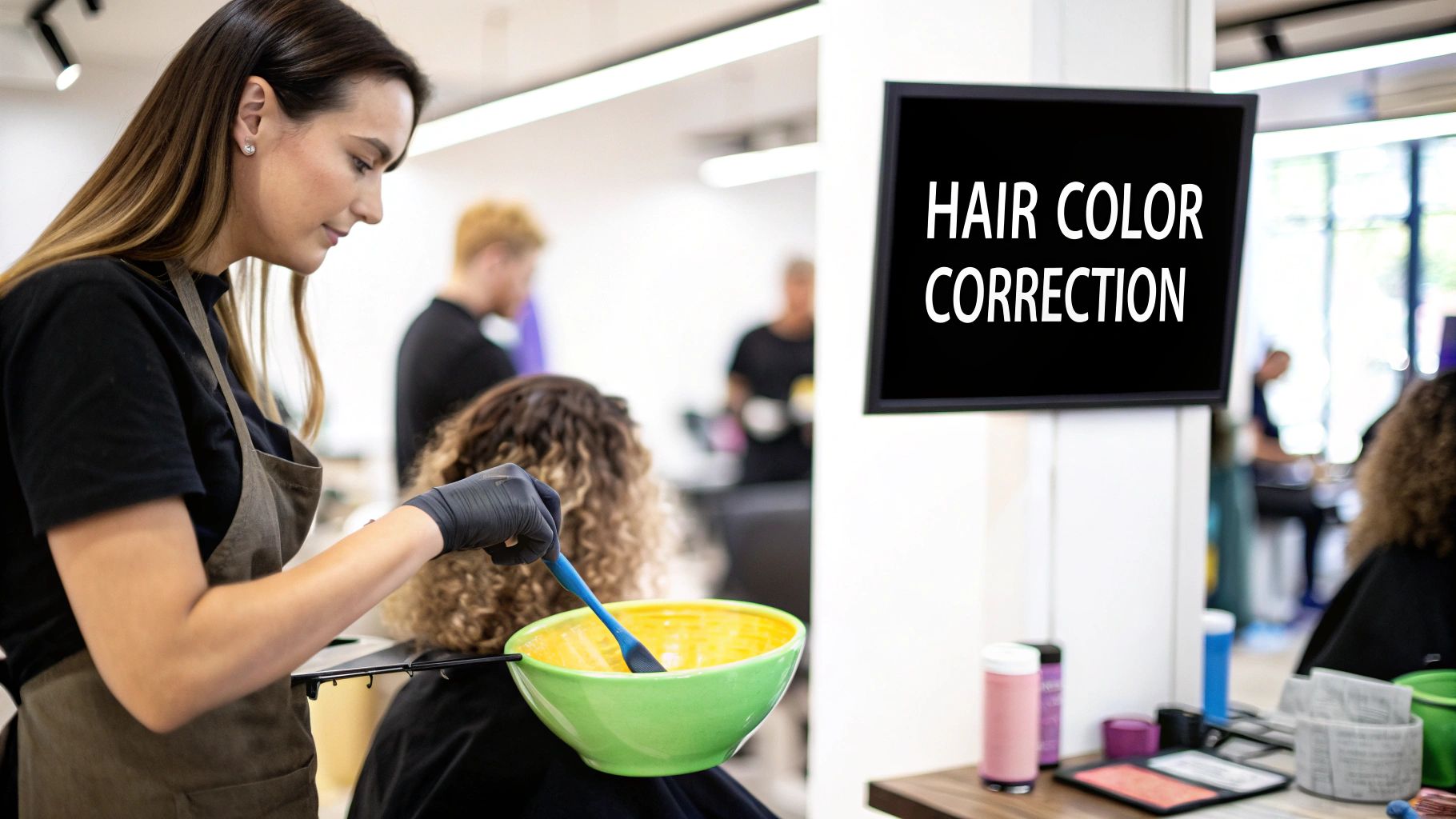
Imagine a painter working on a canvas. If the initial colors are muddy or applied incorrectly, they can't just paint over it and hope for the best. They have to strip back the old paint, prime the surface, and start fresh. That's exactly what a colorist does during a color correction. We're meticulously removing or adjusting the old, unwanted pigments to create a clean slate for your beautiful new shade.
This kind of detailed work has become incredibly common. The global hair color market was recently valued at around USD 26.85 billion, and it's only getting bigger. That huge number tells you a lot—more people are coloring their hair, and sometimes, those experiments don't go as planned, leading them straight to a professional for help.
Common Hair Problems That Need a Pro's Touch
How do you know if you need a simple touch-up or a full-blown color correction? It usually comes down to a few common hair nightmares that a standard appointment just can't fix.
You're likely a candidate for color correction if you're dealing with any of these situations:
- The Box Dye Disaster: We've all been tempted. But when that DIY box dye leaves you with splotchy, uneven color or a shade that's wildly different from the model on the box, it's time for a professional fix.
- Brassiness Overload: Your gorgeous blonde or balayage has slowly turned a funky shade of orange or yellow. If purple shampoo isn't making a dent anymore, you need a colorist to rebalance those tones.
- A Major Color Leap: Going from dark to light (like jet black to platinum blonde) is a journey, not a single appointment. It requires a skilled hand to lift out years of dark pigment without destroying your hair.
- Stripes and Bands: If you see distinct lines of different colors in your hair—often from overlapping color during at-home root touch-ups—that's called color banding. Sometimes, the problem is the opposite, and you need to know how to remove bleach from hair after a lightening attempt went too far.
To make it clearer, let's break down some common issues and what a color correction aims to achieve for each.
Common Hair Color Problems and Correction Goals
| Problem | Description | Color Correction Goal |
|---|---|---|
| Brassy Tones | Blonde or lightened hair has developed unwanted yellow, orange, or reddish hues. | Neutralize the brassiness by applying a toner with opposite pigments (e.g., violet for yellow). |
| Uneven or Patchy Color | Color is inconsistent, with darker spots and lighter areas, often from a DIY job. | Even out the base color by filling in lighter patches and lifting darker spots to create a uniform canvas. |
| Color Banding | Visible horizontal lines or "bands" of different colors from overlapping applications. | Blend the bands seamlessly into the rest of the hair for a natural, cohesive look. |
| Color is Too Dark | The hair color came out much darker than intended, often looking flat or "inky." | Gently lift the dark color by a few shades to reach the desired level and restore dimension. |
| Going from Dark to Light | A major transformation, such as from black to blonde. | Carefully and progressively lighten the hair in stages, removing old pigment while preserving hair health. |
Ultimately, a great color correction is about more than just fixing a bad dye job.
A successful color correction isn't just about fixing a mistake; it's about restoring your hair's balance, integrity, and beauty. It requires a deep understanding of color theory, hair chemistry, and precise application techniques.
The goal is always twofold: get you the color you actually want and make sure your hair is healthy and strong enough to show it off. It’s a delicate balancing act, and it’s what separates a quick, temporary patch from a true, professional hair restoration.
Inside a Professional Color Correction Appointment
A hair color correction isn't your average salon visit. It's an intensive, highly customized process that requires a serious amount of skill and patience. Think of your stylist as a hair detective and artist rolled into one, carefully undoing what’s gone wrong to create a beautiful, even canvas. This is a marathon, not a sprint.
The whole thing kicks off with a detailed consultation. This part is absolutely critical. Your stylist will need your complete hair history—every box dye, every professional color, every chemical service. Be honest! What you don't mention can cause serious chemical reactions later. They'll also perform a strand test, which is like a sneak peek at how your hair will react to the process.
The Correction Process Unpacked
Once your stylist has a solid game plan, the real work begins. There's no one-size-fits-all formula here; it's a careful sequence of treatments chosen specifically for your hair's situation. The goal is always the same: get you to your desired color while keeping your hair as healthy as possible.
Depending on the issue, your stylist might use a few different techniques:
- Color Removers: These are often the first line of defense. They work by shrinking the artificial color molecules in your hair so they can be washed away. It’s a much gentler approach than immediately reaching for bleach, especially for removing dark, stubborn dyes.
- Strategic Bleaching: If a color remover isn't enough or you're aiming for a much lighter shade, bleach is necessary. A pro won’t just slap it on everywhere. They'll use precise application methods, like foils or balayage, to lighten only the specific areas that need it, protecting the rest of your hair from over-processing.
- Fillers and Toners: This is where the color theory magic happens. If you’re going from light to dark, your hair is missing the underlying warm pigments (reds, oranges, golds). A color filler puts those tones back in, preventing your new dark color from looking murky or green. Toners are then used to fine-tune the shade by neutralizing any unwanted tones, like getting rid of that pesky brassiness in new blonde hair.
Here’s a look at the kinds of problems a stylist is trained to spot and solve during that initial assessment.
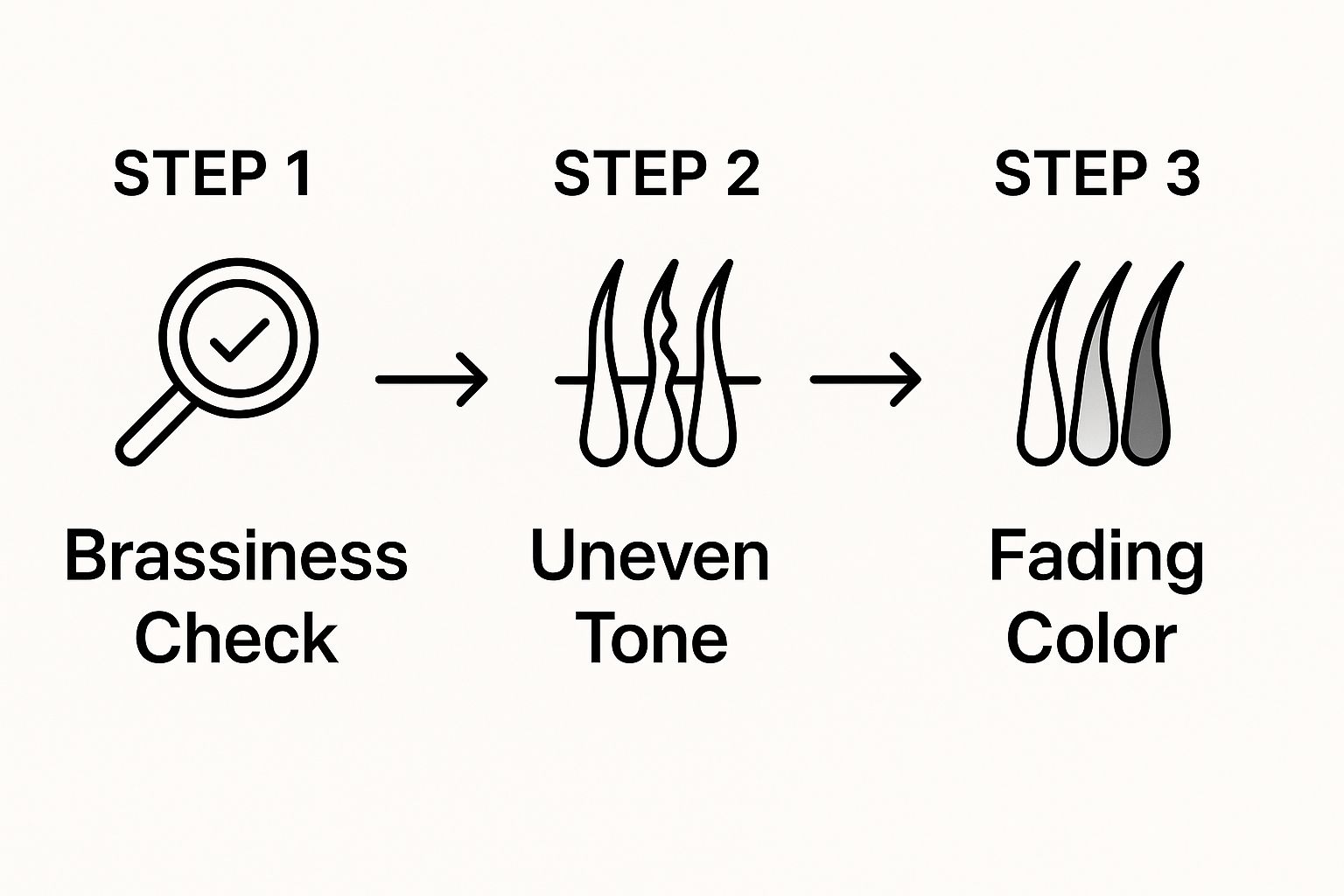
As you can see, it's a methodical process of identifying the problem—from brassy tones to splotchy patches—and then selecting the right tool for the job.
Managing Time and Expectations
One of the most important things to understand is that color correction takes time. A lot of time. Be prepared to clear your schedule, as an appointment can easily last anywhere from three to eight hours, sometimes even longer.
It’s also crucial to have realistic goals. A major transformation, like going from jet black to platinum blonde, will almost certainly require multiple appointments scheduled weeks apart. This gives your hair a much-needed break to recover between sessions.
"A professional color correction is a testament to patience. Rushing the process with high-strength chemicals is the fastest way to cause severe breakage. A slow, steady approach always yields the healthiest and most beautiful results."
If you’re thinking about a dramatic change, it’s worth reading up on what you need to know before dyeing your hair a bold color to get fully prepared. In the end, this deliberate and careful process is the only way to get the hair color you've been dreaming of without sacrificing its health.
Navigating Common Color Correction Scenarios
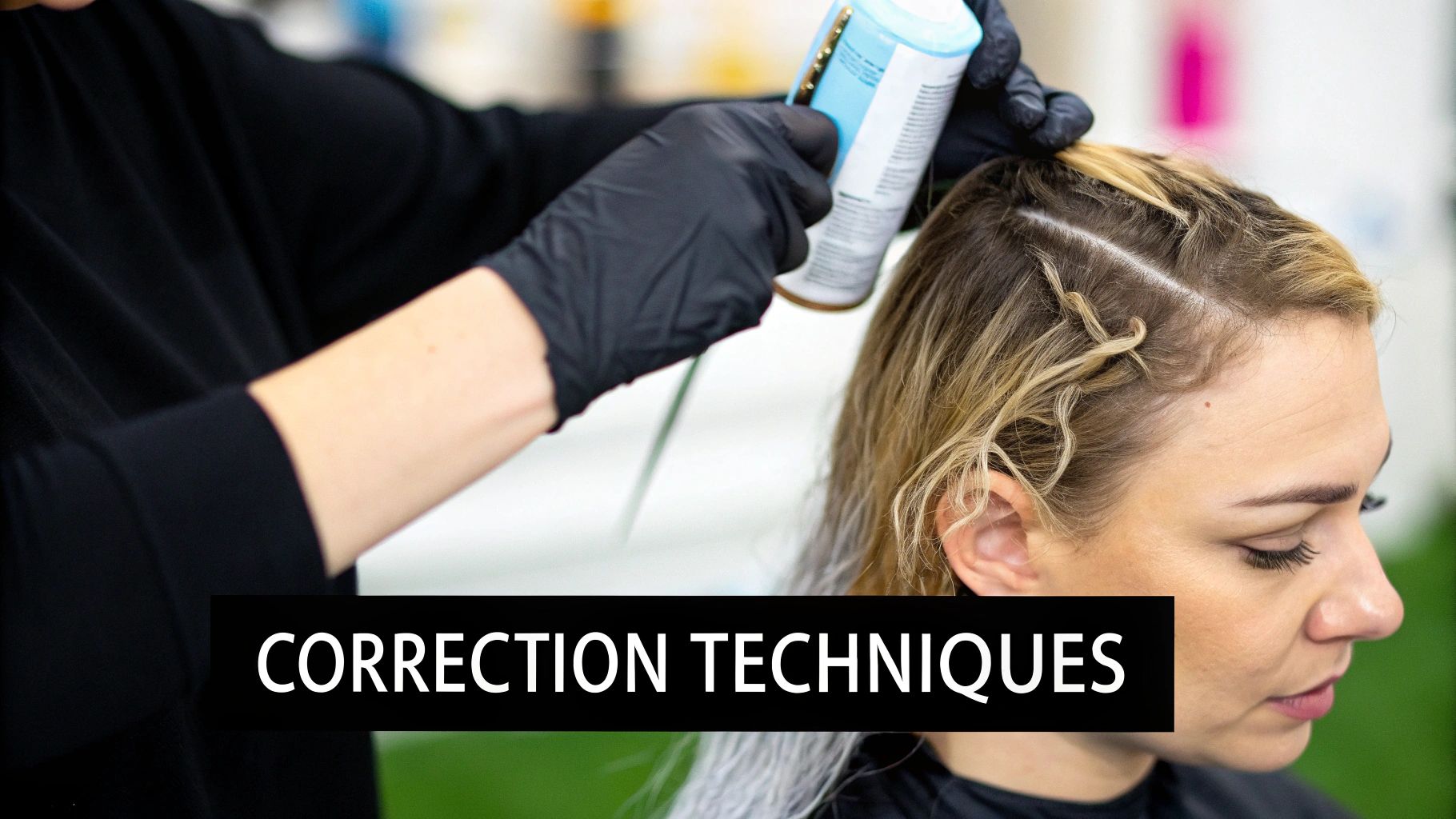
Every color correction that comes through our salon doors has its own backstory, but most of them fall into a few familiar categories. Once you understand these common situations, you can better identify what your own hair might need and appreciate why the process is so involved. These aren't just quick dye jobs; they're complex restoration projects for your hair.
Corrective color services are a huge part of what we do as professionals. Industry estimates show that around 40% of salon visits for color involve some level of correction to nail the final look. With so many people experimenting at home, it’s no surprise that over 60% of hair color users in North America and Europe ultimately turn to a professional to fix things. For a deeper dive, you can explore more insights on the hair color market.
From Dark Box Dye to Bright Blonde
This is one of the most requested transformations—and easily one of the most challenging. Trying to lift hair that's been saturated with dark box dye to a light blonde is a serious undertaking. Think of it like trying to remove layers of old, dark paint from a delicate canvas. You can't just slap a coat of white on top and expect it to look good.
Your stylist has to gently and methodically strip out all that artificial pigment, usually with a specialized color remover or a gentle lightener. This isn't a one-and-done deal; it often takes multiple appointments to lift the color evenly without completely frying the hair. Rushing the process is a surefire way to end up with splotchy orange patches and a ton of breakage.
A slow and steady approach is non-negotiable when going from dark to light. Each session is a calculated step toward the final goal, always prioritizing the hair's integrity above all else.
Going from Light to Dark the Right Way
It might seem simple, but taking a blonde back to a rich brunette is more complex than it looks. When hair is lifted to blonde, its natural warm foundation—all the red, orange, and gold pigments—gets stripped out. If you just apply a brown dye over pale blonde hair, it will often look flat, muddy, or even take on a greenish cast because that essential warmth is missing.
To avoid this disaster, stylists have to "fill" the hair first. It’s a crucial step.
- Assess the Hair: First, the stylist figures out which warm pigments are missing to achieve the target shade of brown.
- Apply a Filler: They'll apply a warm-toned demi-permanent color, like a red, copper, or gold, to put that necessary foundation back into the hair shaft.
- Apply the Final Color: Once that filler has processed, the final brunette color goes on top. This new base ensures the brown looks rich, dimensional, and totally natural.
Banishing Unwanted Tones
This is probably the most common fix we do. It’s all about neutralizing a shade that's gone rogue, and it all comes down to the color wheel.
- Fixing Brassy Tones: If blonde hair has turned an unwanted yellow or orange, a stylist will use a toner with a violet or blue base. These cool colors cancel out the warmth, leaving a cleaner, crisper blonde behind.
- Correcting Ashy Tones: On the flip side, if hair has gone too ashy, looking almost gray or even a bit green, a toner with warm pigments like gold or copper is used to breathe life and vibrancy back into the color.
Fixing Blotchy Color and Harsh Lines
A DIY dye job gone wrong often leaves behind splotchy, uneven color or those dreaded "bands" where new growth meets old color. Fixing this requires an artist's touch. A stylist will use a combination of techniques, meticulously applying lightener to just the dark spots and a darker color to the areas that are too light. This detailed work is all about blending the inconsistencies to create a seamless, beautiful result from root to tip.
Weighing The Costs of Color Correction
Let's talk about the elephant in the room: the price. One of the very first questions I get about a hair color correction is always, "How much is this going to cost me?" It's a fair question, and the honest answer is that it's an investment. This isn't your standard root touch-up; it's a highly specialized, intensive service that demands a ton of skill, time, and premium products to get right without wrecking your hair.
Unlike a predictable, single-process color, there's no flat rate for a color correction. Think of it like a custom renovation for your hair. The final price tag depends entirely on the unique situation we're dealing with. A stylist has to consider how complex the job is, which directly determines how many hours they'll be working and how much product they'll need to use.
A color correction is an investment in your hair's health and your confidence. The cost reflects the stylist's expertise, the hours of meticulous work, and the high-quality products needed to reverse damage and achieve a beautiful, lasting result.
This is exactly why most experienced stylists charge for color corrections by the hour. You can expect rates to start around $100 per hour, and often more. This approach is the only fair way to account for the unpredictable nature of the work. A simple toning adjustment might only take a couple of hours, but a serious battle against years of black box dye could easily turn into a six-hour marathon.
Key Factors That Determine Your Final Cost
So, what exactly goes into that hourly rate? Several key factors will influence the total time and financial commitment for your appointment. Understanding these will help you set realistic expectations for your budget and the process ahead.
- Severity of the Correction: There's a world of difference between toning down some minor brassiness and trying to lift out layers upon layers of dark box dye. The bigger the problem, the more intensive the solution.
- Hair Length and Density: It’s simple math—more hair requires more product and more time to apply it. A client with a short, fine pixie cut will have a very different bill than someone with thick, waist-length hair.
- Number of Sessions: Big changes, especially going from dark to light, almost never happen in one sitting. It's a marathon, not a sprint, and we often have to schedule multiple appointments to get you to your goal color safely.
- Stylist's Expertise: You're paying for experience. A seasoned colorist who specializes in complex corrections will charge a higher hourly rate, but their knowledge is what stands between you and a chemical haircut.
To give you a clearer picture, let's break down a few common scenarios and what they might entail.
Estimated Cost and Time for Common Correction Scenarios
Here’s a general guide to help you understand how different hair situations can affect the time and cost. Remember, these are just estimates—your stylist will give you a more precise quote during your consultation.
| Correction Scenario | Estimated Time (per session) | Estimated Cost Range |
|---|---|---|
| Simple Toner Adjustment | 1.5 – 2.5 hours | $150 – $300+ |
| Fixing Patchy Color | 3 – 5 hours | $300 – $600+ |
| Removing Dark Box Dye | 4 – 8+ hours | $400 – $1,000+ |
| Major Light to Dark Change | 3 – 4 hours | $300 – $500+ |
As you can see, the range is pretty wide. A quick fix is manageable, but a major overhaul is a significant commitment. The best first step is always a thorough consultation to map out a clear plan and get a personalized estimate.
Protecting Your Hair After a Color Correction
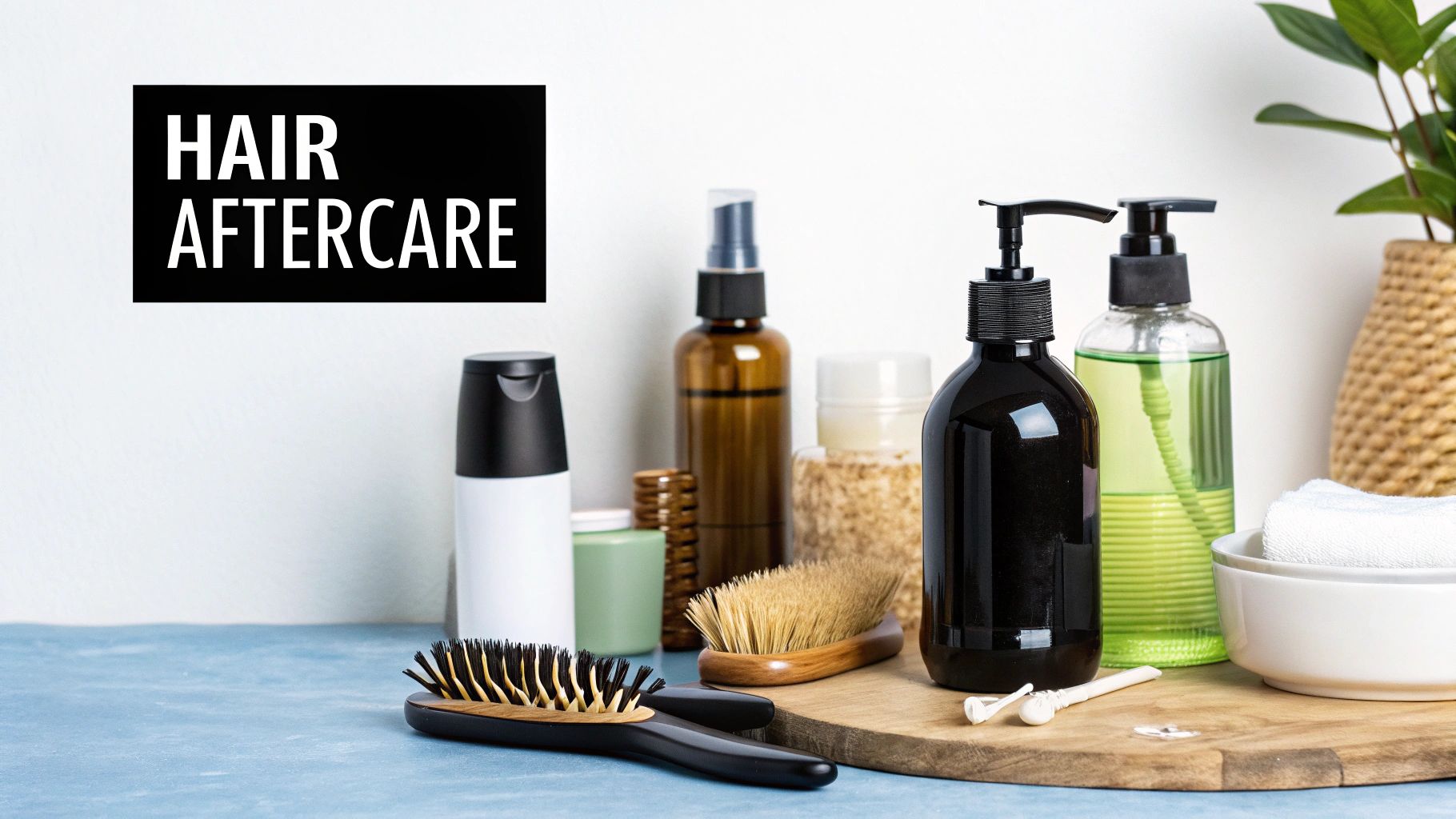
Walking out of the salon with that perfect new color is an amazing feeling, but the work doesn't stop there. Think of your hair like a precious silk garment that's just been meticulously restored—it needs special handling to keep it looking beautiful. Honestly, what you do at home is just as critical as what your stylist achieved in the chair.
The first, most immediate change you need to make is in your shower. Those harsh sulfates lurking in many drugstore shampoos are the number one enemy of fresh color. They strip out both pigment and moisture, which is the absolute last thing your hair needs right now. Switching to a sulfate-free, color-safe shampoo and conditioner isn't just a suggestion; it's essential for keeping that new shade from literally going down the drain.
Rebuilding Strength and Locking in Moisture
After a color correction, your hair is practically begging for hydration and protein. This is the perfect time to get serious about a weekly routine involving deep conditioners and bond-building treatments. These aren't just fancy conditioners; they're formulated to dive deep into the hair shaft and repair the structural bonds that get broken down during the coloring process.
Think of your at-home hair care as the insurance policy on your color correction. A little consistent effort with hydration and gentle care will protect your investment, keeping your hair healthy and your color brilliant for so much longer.
Beyond the products you use, a few simple tweaks to your daily habits can make a world of difference in protecting your hair’s health and color.
- Go Easy on the Shampoo: Try to extend the time between washes. Every time you shampoo, you risk a little bit of color fade. When you do wash, stick to lukewarm or cool water. Hot water swells the hair cuticle, creating an easy escape route for those precious color molecules.
- Lower the Temperature: Your hair is in a more fragile state, so now is the time to dial back the heat styling. Give your flat iron and curling wand a little break. If you can't live without them, always, always use a quality heat protectant spray first and turn the tool to its lowest effective heat setting.
- Use the Right Stuff: The products you choose matter. A lot. For some great recommendations, you can explore our list of the best hair products for color-treated hair to find formulas designed to nourish and protect.
Making these small adjustments a part of your routine is the best way to safeguard the time and money you've put into your hair. You're not just maintaining a color; you're nurturing the health of your hair so it stays shiny, strong, and stunning.
Frequently Asked Questions About Color Correction
It's completely normal to have a ton of questions when you're thinking about a color correction. Let's walk through some of the most common ones I hear in the salon.
Is It Safe to Do a Color Correction at Home?
I'm going to be blunt: attempting a major color correction with a box dye from the drugstore is a recipe for disaster. What we do in the salon is a delicate dance of color theory and hair chemistry, and it’s something that takes years to master.
A DIY job can go wrong in so many ways, from patchy, uneven color to serious chemical damage. In the worst-case scenario, you could end up with what we call a "chemical haircut"—where your hair is so compromised it literally breaks off. It's just not worth the risk.
The stakes are high with corrective color. A professional isn't just applying dye; they're strategically preserving your hair's integrity with every step, a skill that can't be replicated with a box kit.
How Long Will My Appointment Take?
Get comfortable, because this is definitely not a quick in-and-out service. A color correction appointment can easily take anywhere from three to eight hours, and sometimes even longer.
The final time really depends on what we're fixing, how long your hair is, and its current condition. It’s a very meticulous, step-by-step process, so you’ll want to clear your entire day for it.
Will This Process Ruin My Hair?
This is a huge concern, and for good reason. While any chemical service has some level of risk, a good stylist’s number one priority is keeping your hair healthy. We always perform strand tests to see how your hair will react and use bond-building treatments throughout the service to protect it.
Your hair might feel a little different after, but the whole point of a professional correction is to get you to your goal color without destroying your hair’s integrity. Often, we have to split the process into multiple sessions, especially for big changes like going from black to blonde. Spacing appointments several weeks apart gives your hair a much-needed break to recover and ensures we can lift out the old color safely.
Ready to achieve the beautiful, healthy hair you've been dreaming of? At Hairicc, our expert stylists specialize in complex color corrections and transformative services for all hair types. Book your consultation today and let us create a personalized plan to bring your hair goals to life.
